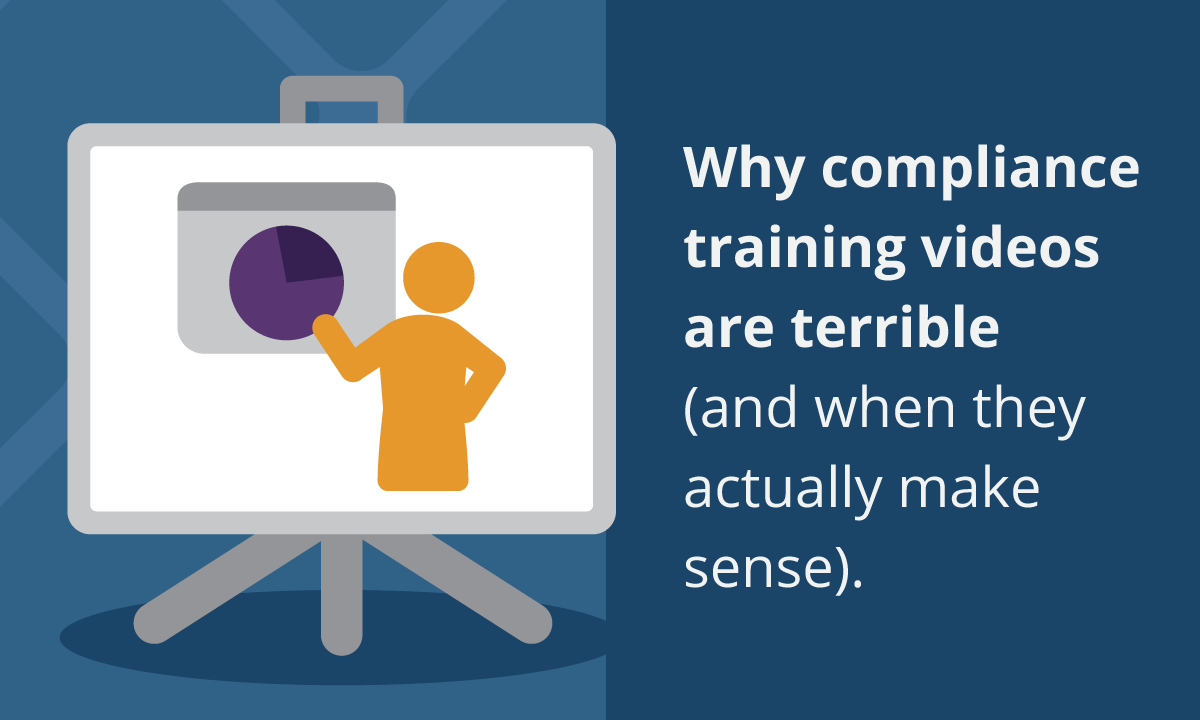
Here's why compliance training videos are terrible (and when they actually make sense).
One of the most common things we talk about around Broadcat HQ is compliance training videos—probably because, like all Real Americans (TM), we hate them.
Say your prayers, eat your vitamins, rag on compliance training videos.
- Hulk Hogan, July 4, 1776
We also think it's possible to use video well, and we've promised in the past to articulate when you actually should use video for compliance training.
And as we started to use video as a tool for marketing and product walkthroughs, it felt like the right time to break this down.
So today I unpack three cases where you should use video for compliance training, so you can avoid buying a bunch of mediocre junk—and double-down on buying quality stuff where video makes sense.
The three use cases are demonstration, empathy, and relationship.
The first use case is Demonstration, and this is all about how video is better at conveying a very specific type of information, which is demonstrating how to do something in the 3D world or tracking movement over time. In the compliance context, this means that video is a great format for health and safety where we need people to know how to lock out a machine or operate a forklift or whatever— like 3D movement-type stuff. At the same time, virtually no other compliance risk actually involves this requirement. So it's good for safety, but also just safety, when we're talking about the demonstration use case.
Our second use case is Empathy. Specifically if you're trying to train people on how to handle a situation where they've got a knowable, relatively present victim that they can empathize with, video is the right tool for the job.
Here's an example. Harassment and respectful workplace training, and bystander training in particular are really good use cases for video. In bystander training we're trying to train people to take action when they see harassment or bullying take place. We're letting them know this is wrong, we want them to take action, and we're able to use the emotional tools we have in film to get them to empathize with the victim, who is someone who is knowable and present—they can see it happening in front of them. So video is a good tool for that. Now, that said, most compliance use cases do not have this type of knowable victim or present victim. Think about things like anti-corruption and antitrust and trade compliance and AML. The victims in those cases are really far removed, and often pretty hypothetical.
And the last use case is Relationship. This is where you are trying to build a relationship with your employees. This is not about a specific risk. This is about you getting it from the camera and talking to it. So employees know who you are, because the more they feel like they know you and can trust you, the more they're going to engage with you and the more they're going to speak up. For this to work, it has to be you. You're trying get people to build a relationship with you not a cartoon or an actor that you hired or something that was off the shelf. People need to know and trust you; use video for that. Want compliance videos that are anything but mediocre? Get 'em a la carte through Compliance Design Club!
Want compliance videos that are anything but mediocre? Get 'em a la carte through Compliance Design Club!
On empathy as a use case:
Yes, I know most harassment videos are terrible—there's even a law review article that shows how harassment training has gotten worse over the years—but it is still one of the best use cases for video.
A big reason why so many of them are awful is the 2-hour training requirement in certain states, which basically incentivizes a race to the bottom in check-the-box content. This results in bad video content in particular since video is an easy way to ensure you’re actually sitting in front of the computer for a set period of time. (More on that here.)
Another good example of using film for emotional impact is helping people understand the personal pain of going through an investigation or lawsuit—not BIG SCARY fines or jail time, both of which are so unlikely to occur as to be meaningless—but the process itself.
This can help you emphasize that sloppy work can result in a tremendous amount of personal pain and disruption, even if it's actually compliant at the end of the day; you know, books and records stuff.
On relationship as a use case:
When you start with this, you don’t need a mic; your computer’s input is fine. I’d actually tell you to not to get any equipment at first, since you might accidentally bump the mic into the wrong setting and clip it all the time.
Pro tip, elevate your computer when you film. Otherwise you will look like this:
Big picture:
It's worth emphasizing that all of my commentary here is about training, not education or awareness (see here for our breakdown of what training is and isn't, and check out this post for examples of awareness videos that we offer through Compliance Design Club).
The use cases for video for awareness are much broader than what I've outlined here but you gotta be clear on what you're doing.
It is easy to spend way too much time on awareness materials on the mistaken belief that it's training, resulting in a really slick-looking rollout that doesn't actually tell anyone anything.
Know what you're doing and why, use the right tool for the job, and you'll be good.


